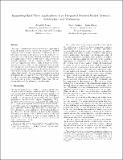| dc.contributor.author | Clark, David D. | |
| dc.contributor.author | Shenker, Scott | |
| dc.contributor.author | Zhang, Lixia | |
| dc.date.accessioned | 2002-07-23T16:25:44Z | |
| dc.date.available | 2002-07-23T16:25:44Z | |
| dc.date.issued | 1992-08 | |
| dc.identifier.uri | http://hdl.handle.net/1721.1/1543 | |
| dc.description.abstract | This paper considers the support of real-time applications in an Integrated Services Packet Network (ISPN). We first review the characteristics of real-time applications. We observe that, contrary to the popular view that real-time applications necessarily require a fixed delay bound, some real-time applications are more
flexible and can adapt to current network conditions. We then propose an ISPN architecture that supports two distinct kinds of real-time service: guaranteed service, which is the traditional form of real-time service discussed in most of the literature and involves pre-computed worst-case delay bounds, and predicted service,
which uses the measured performance of the network in computing delay bounds. We then propose a packet scheduling mechanism that can support both of these real-time services as well as accommodate datagram traffic. We also discuss two other aspects of an overall ISPN architecture: the service interface and the admission control criteria. | en |
| dc.description.sponsorship | Research at MIT was supported by DARPA through NASA Grant
NAG 2-582, by NSF grant NCR-8814187, and by DARPA and NSF
through Cooperative Agreement NCR-8919038 with the Corporation
for National Research Initiatives.
| en |
| dc.format.extent | 232768 bytes | |
| dc.format.mimetype | application/pdf | |
| dc.language.iso | en_US | |
| dc.subject | fixed delay bound | en |
| dc.subject | Integrated Services Packet Network | en |
| dc.subject | ISPN | en |
| dc.subject | real-time applications | en |
| dc.title | Supporting Real-Time Applications in an Integrated Services Packet Network: Architecture and Mechanism | en |
